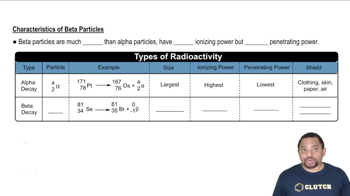Here are the essential concepts you must grasp in order to answer the question correctly.
Radioactive Decay
Radioactive decay is the process by which unstable atomic nuclei lose energy by emitting radiation. This can occur through various modes, including alpha decay, where an alpha particle (two protons and two neutrons) is emitted, and beta decay, where a neutron is transformed into a proton, emitting a beta particle (an electron or positron). Understanding the type of decay is crucial for predicting the products of a decay series.
Recommended video:
Rate of Radioactive Decay
Decay Series
A decay series is a sequence of radioactive decays that an unstable nucleus undergoes until it reaches a stable end product. In the case of thorium-232, it undergoes multiple decays, including both alpha and beta emissions, before transforming into lead-208. Each step in the series alters the atomic number and mass number, which is essential for determining the total number of emitted particles.
Recommended video:
Alpha and Beta Particles
Alpha particles consist of two protons and two neutrons, making them relatively heavy and positively charged, while beta particles are high-energy, high-speed electrons or positrons emitted during beta decay. The emission of these particles affects the atomic and mass numbers of the decaying element, which is vital for calculating the total number of each type of particle emitted during the decay process.
Recommended video:
Characteristics of Beta Particles
 Verified step by step guidance
Verified step by step guidance

